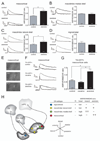Projection-specific modulation of dopamine neuron synapses by aversive and rewarding stimuli
- PMID: 21658580
- PMCID: PMC3112473
- DOI: 10.1016/j.neuron.2011.03.025
Projection-specific modulation of dopamine neuron synapses by aversive and rewarding stimuli
Abstract
Midbrain dopamine (DA) neurons are not homogeneous but differ in their molecular properties and responses to external stimuli. We examined whether the modulation of excitatory synapses on DA neurons by rewarding or aversive stimuli depends on the brain area to which these DA neurons project. We identified DA neuron subpopulations in slices after injection of "Retrobeads" into single target areas of adult mice and found differences in basal synaptic properties. Administration of cocaine selectively modified excitatory synapses on DA cells projecting to nucleus accumbens (NAc) medial shell while an aversive stimulus selectively modified synapses on DA cells projecting to medial prefrontal cortex. In contrast, synapses on DA neurons projecting to NAc lateral shell were modified by both rewarding and aversive stimuli, which presumably reflects saliency. These results suggest that the mesocorticolimbic DA system may be comprised of three anatomically distinct circuits, each modified by distinct aspects of motivationally relevant stimuli.
Copyright © 2011 Elsevier Inc. All rights reserved.
Figures




Comment in
-
Multiple personalities in the ventral tegmental area.Neuron. 2011 Jun 9;70(5):803-5. doi: 10.1016/j.neuron.2011.05.024. Neuron. 2011. PMID: 21658574 Free PMC article.
References
-
- Abercrombie ED, Keefe KA, DiFrischia DS, Zigmond MJ. Differential effect of stress on in vivo dopamine release in striatum, nucleus accumbens, and medial frontal cortex. J. Neurochem. 1989;52:1655–1658. - PubMed
-
- Bellone C, Luscher C. Cocaine triggered AMPA receptor redistribution is reversed in vivo by mGluR-dependent long-term depression. Nat. Neurosci. 2006;9:636–641. - PubMed
Publication types
MeSH terms
Substances
Grants and funding
LinkOut - more resources
Full Text Sources
Other Literature Sources

